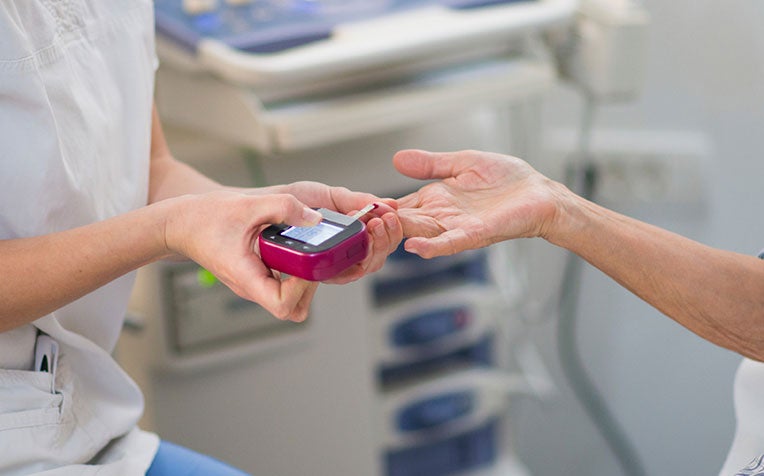
The HbA1c test is used to measure one's blood glucose level.
One of the more important tests in diagnosing diabetes is the HbA1c test.
Before physical symptoms of diabetes are even noticed, high levels of blood sugar in the body may already have caused damage to some parts of the body. Keeping checks on your blood sugar levels is just one of the steps you can take to nip potential problems in the bud.
One of the more important tests in diagnosing diabetes is the HbA1c test. “For people with diabetes, this is an important test as the higher the HbA1c reading, the higher is the risk of developing diabetes-related complications,” says Dr Suzieani binte Zainudin, Associate Consultant, Department of Endocrinology, Singapore General Hospital (SGH), a member of the SingHealth group.
1. What are the different tests to determine if one has diabetes or prediabetes?
Based on Ministry of Health’s clinical practice guidelines released in January 2014, diabetes mellitus (more commonly known as diabetes) is diagnosed with one of the following:
a. If any abnormal laboratory test results has been confirmed on repeat testing,
| Plasma Glucose Level (In Mmol/L) | Diabetes Mellitus | Prediabetes | |
|---|---|---|---|
| Impaired fasting glycaemia | Impaired glucose tolerance | ||
| Fasting | ≥7.0 | 6.1-6.9 | <7.0 |
| 2-hour post 75g oral glucose tolerance test | ≥11.1 | <7.8 | 7.8 – 11.0 |
| Random | ≥11.1 |
b. the presence of typical symptoms of diabetes such as increased thirst, frequent urination, increased hunger with unexplained weight loss and the laboratory readings meeting the criteria above, or
c. admission to hospital for excessive glucose in the bloodstream or severe hyperglycaemia, which is due to the worsening of the symptoms mentioned above (b), and this is termed hyperglycaemic crisis.
Meanwhile prediabetes (a condition where the blood sugar level is abnormally high in a person but not all of the symptoms of a person with diabetes are present), which is impaired fasting glycaemia or impaired glucose tolerance, is diagnosed using the criteria as stated in the table above.
2. What is HbA1c?
A term commonly used in relation to diabetes, HbA1c stands for glycated haemoglobin, which is haemoglobin to which glucose is bound.
3. How is it measured?
It is measured using a laboratory blood test with blood drawn from vein (venal method), or point-of-care testing, which uses blood from a finger-prick.
4. What does the test measure?
It measures the control of one’s blood glucose level over the previous three months, from the date of testing.
5. Why is this measurement important to people who have diabetes?
This measurement is important as large-scale trials have shown evidence that its value can predict the risk of developing complications in various organs such as the eyes, kidneys, nerves and heart, in the future.
6. Does it give an accurate average measurement of blood glucose?
It has been shown to predict the average blood glucose level via a derived formula. For example, an HbA1c value of 6.7 per cent would predict an average blood glucose level of 8.1mmol/L based on the formula.
7. What can affect the accuracy of this measurement?
The results can be affected by problems due to interactions with the investigative procedure (assay) used in the measurement such as in renal failure and disorders of haemoglobin, and conditions that affect lifespan of red blood cells such as iron deficiency anaemia. Hence, in these conditions, alternative methods of monitoring glucose control such as capillary glucose monitoring is needed.
8. What should the HbA1c levels be?
This level should be kept at 7 per cent or less in most patients except in patients with very high risk of low blood glucose level, where it needs to be kept at a higher level.
9. Which method is preferred and why? The finger-prick or venal blood method.
The laboratory test using venous blood is preferred in most cases as a laboratory would use a method that undergoes certification and standardisation to maintain the accuracy of test results. On the other hand, the point-of-care testing uses finger-prick blood, which although may not be as accurate, is more convenient as results are rapidly available. Hence, it is deemed suitable for monitoring in most patients.
10. What’s a better choice then?
If you are otherwise well, with no other medical conditions that may affect the results of the HbA1c test results, and is able to go for venous blood test as well as return for the pick-up of the test results on another day, it will be best to perform the venous blood test to be sent to a laboratory.
“Getting this HbA1c test, as well as other diabetes-related tests, done at least once a year is crucial in helping someone with diabetes manage his or her condition better,” says Dr Suzieani.
Ref: Q15
Contributed by


















 Get it on Google Play
Get it on Google Play